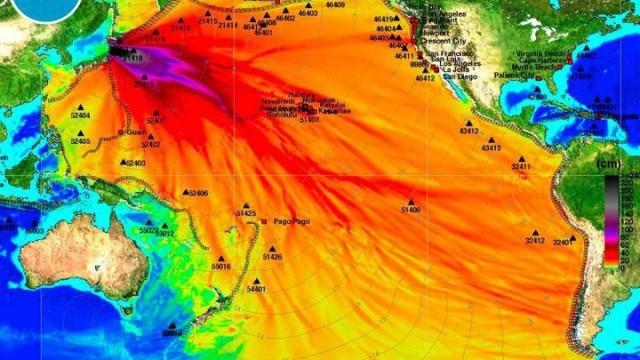The Fukushima "Coverup"

Sometimes you see something that makes you sigh. People often bring up Fukushima as a reason why nuclear energy is an unsafe method of green energy generation.

It's hard to combat that when you see scary images, as you see above. This is an article that was ripped off of another website that references a third website that is a summary of an anti-nuclear activist speaking at an anti-nuclear presentation where no actual sources were presented. It kind of hurt my head to read all of it, but that's what I'm here for. Oh, the above picture is of wave heights following a tsunami. It has nothing to do with radioactive contamination.
Before I rip it apart, I'll give full disclosure: I have about a decade worth of experience working on nuclear power plants in one capacity or another. I switched industries, so I have the virtue of being familiar with atomic power while not being beholden to it anymore for a paycheck. I still think it's one of our best energy sources, and I live close to a nuclear plant without fear.
Alright, first things first: The UN has released a report [1] that I'll be drawing from heavily. It's about 300 pages, and I've included an archived copy at the bottom of this post if you have some free time.
Here's the first interesting bit: The average person living near Fukushima got about 2.1mSv of radiation exposure per year before the accident. This comes from a variety of sources. Granite emits radiation. Bananas emit radiation. Your bones emit radiation. The aftershocks of the Big Bang emit radiation. There's no escaping it anywhere in the universe.
Guess how much radiation dose individuals living in Fukushima got in the first year? About four mSv. For comparison, that's just a tiny bit more than the average X-ray technician gets yearly. How do we know this? Dosimetry, mass spectrography, and differential equations. The math gets a little cattywampus, but radioactive decay can be modeled very accurately with decaying exponentials for each individual radioactive isotope. It's pretty cool and a worthy field of study.
People living near the nuclear plant itself got around 12-25mSv of dose during the first year following the accident. That's about what you'd get when getting a Positron Emission Topography (PET) scan and about half of what you'd get during a Computed Tomography (CT) scan. Due to radioactive decay, it'll be less every year until it eventually returns to average background radiation.
Regardless, it's still less than the US federal limit of 50mSv for radiation workers. No worries.
OK, now that we've looked at some numbers, what about deaths? Good news again. The UN concluded that there were "no radiation-related deaths or acute diseases [observed] among the workers and general public exposed to radiation from the accident." These are easy to track because hospitals keep detailed charts on every patient. After the accident, special attention was paid to symptoms presented that resemble radiation-related injuries. Bio-accumulation of radioactive fission byproducts can be measured, quantified, and recorded. Science is crazy like that.
The report says that the most negative impact of the nuclear accident is Post Traumatic Stress from the evacuation. It did not list deaths due to the dangers of evacuation, which did occur. I'm sure that the decision to displace thousands of people during a natural disaster was not easily made. However, it is best to err on the side of caution lest we repeat what happened during the Chornobyl disaster several decades ago.
Anyway, I think that adequately debunks websites claiming "over 6000% increase in cancer!!!"
What about the alleged cover-up? Well, I can't say that TEPCO handled the disaster very well. It is perfectly acceptable to be angry about that. However, experts believe that the Japanese government's response significantly reduced the negative impact of the disaster. Don't forget that one of the worst natural disasters in human history killed over 20,000 people at the time that caused the mess. With inadequate infrastructure and facing mass casualties, no organization will have a flawless response. Remember, the tsunami destroyed everything in the surrounding area.
OK, next topic: Dumping radioactive coolant into the ocean. Yes, it happened. Fortunately, dilution is the solution to that type of pollution. The picture at the top of this article is often shown as "radiation leakage" or something similar. That's a hoax. It's actually a wave height graph following the tsunami. How about the ocean itself? The radioactive contamination from Fukushima was quickly diffused in the Pacific Ocean's massive volume. By the time any isotopes reached the middle of the sea, they were already outclassed by the natural radioactivity of seawater. Yeah, everything is radioactive, even you! Though Fukushima was a terrible disaster, it did give scientists an excellent way to learn about Pacific Ocean currents.
What else are people saying? Some have suggested that the government somehow orchestrated it. That's a bit ridiculous, considering I don't think we have developed weather control.
Oh, wait, InfoWars thinks we do.
Nevermind.
Sigh.
Feel free to leave your thoughts in the comments section.
Bibliography:





Member discussion